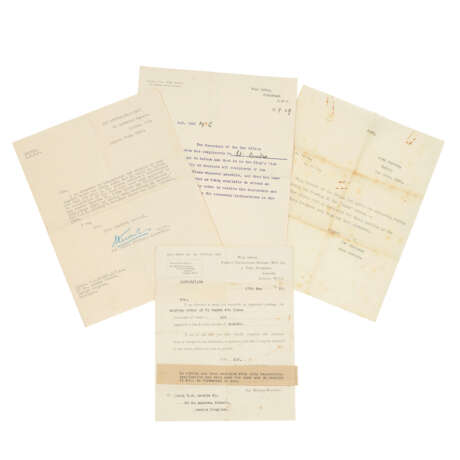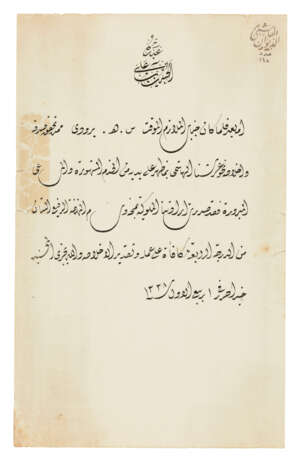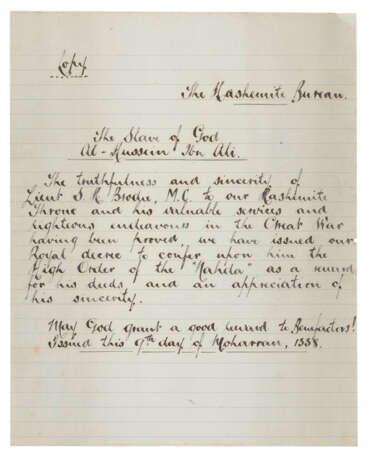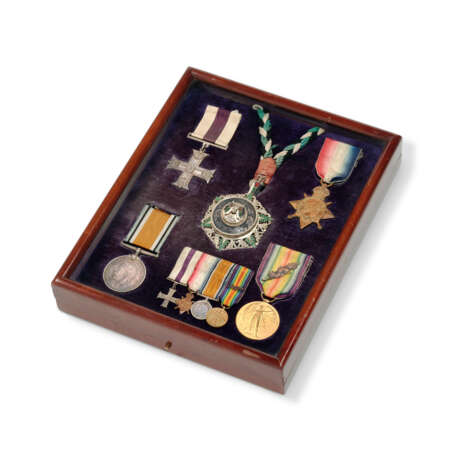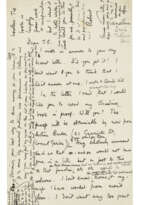ID 794613
Lot 235 | BRODIE, Lt Samuel H. (1886-1971)
Valeur estimée
£ 3 000 – 5 000
A Great War M.C. group of five awarded to Lieutenant Samuel H. Brodie, Royal Field Artillery.
Lots 233 to 235 are offered by descent from Samuel H. Brodie, a lieutenant in the Royal Field Artillery (R.F.A.), served under T.E. Lawrence during the Arab Revolt, 1917-1918. Based at Azrak, the oasis near Aqaba, from where Lawrence led the raids to disrupt the Turkish Army’s Hejaz Railway, Brodie commanded, along with his fellow officer George C. Pascoe, the Ten-Pounder Talbot Battery attached to the Hejaz Armoured Car Company (see 'Nominal Roll: Hejaz Armoured Car Company', Seven Pillars of Wisdom, Appendix I).
Military Cross, G.V.R. (unofficially engraved Lieut. S.H. Brodie. R.H. & R.F.A. 1918); 1914-15 Star (4213 BMBR S. Brodie R.F.A.); British War and Victory Medals, with MID Oak Leaf (Lieut. S.H. Brodie.), very fine.
Miniature Awards: Military Cross, G.V.R.; 1914-15 Star; British War and Victory Medals, with MID Oak Leaves, one clasp, very fine.
Hejaz, Order of El Nahda, 4th Class, comprising neck badge in silver, gilt and enamels, with flag suspension, very fine.
Brodie’s war time medals, including the Military Cross (M.C.), and the order of the Nahda (The Renaissance), the latter awarded by King Hussain complete with presentation certificate in Arabic (worn), and other associated correspondence; the medals in a glazed wooden presentation box.
Lawrence’s description of Brodie’s artillery unit gives the reader a flavour of the men and machines:
‘… the mountain-gun section on Talbots … was an odd unit which General Clayton had seen in Egypt, and had sent down to us in an inspired moment. Its six Talbots, specially geared for heavy work, and were good, but inferior to the Rolls in having artillery wheels (unstable in our changing climate) and only single wheels in front. This made them less nimble than the armoured cars over treacherous surfaces, and in addition their torque-rod brackets were too weak and were continually breaking, until at last the railway workshop in Cairo made us a set in phosphor-bronze, and forever cured that difficulty.
'They carried two ten-pounder guns, and were manned by British gunners who were technically excellent. It was wicked to have given good men such rotten tools; yet the inferior weapons were hardly noticeable in the greatness of the spirit of the men. Their Captain [sic] Brodie was a silent Scotsman, never very buoyant or very anxious, a man whom difficulties were shameful to notice, and who stamped himself on his subaltern, Pascoe, and on his men. However hard the duty given them, they attacked it with such untroubled determination that their will always prevailed. Brodie seemed able to pick up his unit, and carry it forward with him over every obstacle. On every occasion and in every crisis they were always in place at the right moment, perspiring but imperturbable, with never a word in explanation or complaint.’ (Seven Pillars of Wisdom, Oxford ed., p.517; 1935 ed. p.458).
Lawrence himself was an exponent of mobile armoured warfare, and laid out his thoughts in ‘Evolution of a Revolt’, first printed in the Arab Bulletin, and then reprinted in Oriental Assembly (1939, pp.126-7). General Clayton was obviously of the same mind, and Brodie was sent to Matruh in Egypt’s Western Desert in February 1917 to raise such a mobile artillery unit.
Brodie's military career is very interesting. One of the photographs in the previous lot shows Brodie wearing a uniform with corporal's stripes. The reverse of his 1914-15 Star is engraved with the rank of bombardier. At this time, the only regiment of the British Army to use the rank of bombardier was the Royal Horse Artillery, and the 'R.H.' engraved on Brodie's Military Cross confirms he served with this regiment. Brodie was thus commissioned from the ranks, and it is likely he moved regiment from the Royal Horse to the Royal Field Artillery for the Hedjaz campaign.
After testing and training, Brodie was then sent with his new unit to the Hedjaz, arriving in Aqaba on 21 November 1917. Initially, the Talbots were used for transporting stores and personnel, including Prince Feisal, up to Guwaira. Once encamped there, the Talbots joined the armoured Rolls-Royces to form the Hejaz Armoured Car Company. Military operations started in earnest on 1 January 1918, with an attack on Tel El Shahm station, followed 6 days later with an attack on Mudawwara station. This latter was attacked a number of times over the course of the year.
It is notable that because of problems with resupplying such a unit with petrol, Lawrence’s Hejaz Armoured Car Company rarely ventured more than 100 miles from their operating base. Nonetheless, as Brodie’s War Diary makes clear, the unit was actively and effectively engaged in multiple attacks on the Hedjaz Railway.
The Order of the El Nahda (The Renaissance) was bestowed by King Hussain Bin Ali of the Hedjaz upon British subjects for their services during the Arab Revolt. Initial manufacture of the order may have been French, but later awards were made by local silversmiths in Mecca. Brodie's award of El Nahda was published in the London Gazette on 8 March 1920 (Pascoe received his the same day), although the accompanying brevet (in Arabic with separate English translation) gives the earlier date of 7 October 1919:
The Hashimi Diwan.
The Slave of God.
Hussein Bin Ali.
The truthfulness and sincerity of Lieutenant S. H. Brodie M.C. to our Hashimite Throne, and his valuable services and righteous endeavours in the Great War having been proved, we have issued our Royal Decree to confer upon him the High Order of the 'Nahda' as a reward for his deeds and as an appreciation of his sincerity.
May God grant a good reward to Benefactors! Issued this ninth day of Moharram 1338.
Accompanying the lot are four other letters to Brodie relating to the receipt of his awards.
References: ‘George C. Pascoe’ in The Journal of the T.E. Lawrence Society. Vol. IX, No. 1 Autumn 1999, pp.28-34; H. St. J.B. Armitage & J.H. Pascoe, ‘The 10 Pounder Motor Section R.F.A. Hedjaz Operations’ in The Journal of the T.E. Lawrence Society. Vol. X, No. 1 Autumn 2000, pp.13-48.
| Artiste: | Thomas Edward Lawrence (1888 - 1935) |
|---|---|
| Lieu d'origine: | Jordanie, Asie |
| Artiste: | Thomas Edward Lawrence (1888 - 1935) |
|---|---|
| Lieu d'origine: | Jordanie, Asie |
| Adresse de l'enchère |
CHRISTIE'S 8 King Street, St. James's SW1Y 6QT London Royaume-Uni | |
|---|---|---|
| Aperçu |
| |
| Téléphone | +44 (0)20 7839 9060 | |
| Commission | see on Website | |
| Conditions d'utilisation | Conditions d'utilisation |

